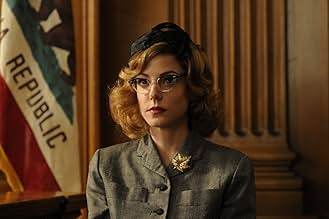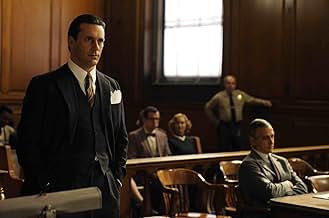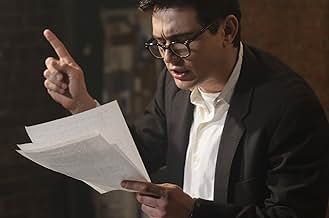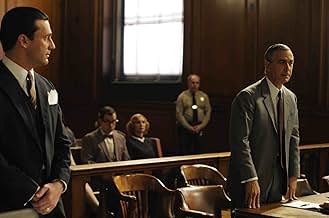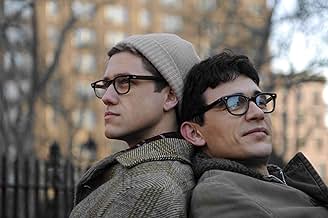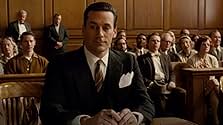As Allen Ginsberg talks about his life and art, his most famous poem is illustrated in animation while the obscenity trial of the work is dramatized.As Allen Ginsberg talks about his life and art, his most famous poem is illustrated in animation while the obscenity trial of the work is dramatized.As Allen Ginsberg talks about his life and art, his most famous poem is illustrated in animation while the obscenity trial of the work is dramatized.
- Directors
- Writers
- Stars
- Awards
- 2 wins & 8 nominations total
Kaydence Frank
- Allen's Girlfriend
- (as Kadance Frank)
Allen Ginsberg
- Self
- (archive footage)
- Directors
- Writers
- All cast & crew
- Production, box office & more at IMDbPro
Featured reviews
I'm surprised that this film worked as well as it did, and that it has been received as well as it has here. I read Howl about 5 years after Ginsberg wrote it, when I was in high school, and, like it or not, it became part of my thinking in the fifty years since then. Still in high school, I could quote passages from the poem at my friends, who would follow up with the next passage, etc. Boooring. But if you had told me that a film would be made about it, with a script constructed of trial transcripts and interviews in the public record, alternating with a recreation of Ginsberg's first public (paying-public; there was ONE previous reading of the full poem) reading of the poem, I wouldn't have expected much. And I would have been wrong. It's well-done and well-acted, and no excuses are made for anything about Ginsberg or his work. I was dismayed at first to see the poem interpreted into animation, but the filmmakers were savvy enough to produce the animation in the style of the times, i.e., 1955, when Disney's Fantasia was still the state of the art, and the animation in Howl could have come out of the Night on Bald Mountain section. In the end, it worked, I think, by keeping the viewer visually in the world of the poem itself, rather than in the biographical material about Ginsberg or the trial and the litigants. So if you want to watch a movie about a poem, and the poet and his friends, but mainly about the poem, this one does a pretty good job.
In admiration of James Franco and his portraying a literary person is why I wanted to see this film. Since I'd never read the poem "Howl" by Allen Ginsberg (& I knew of Ginsberg in his later years as he was fairly renown as almost an elder poet statesman), I actually dug up a copy of "Howl" and read it before I viewed the movie. It turns out that it wasn't necessary to have read "Howl" -- the film sufficiently presents the poem and its complete text so that the viewer gets a good understanding just from the movie itself (at least I thought so...). This occurs in not only Franco's public reading of "Howl," it is brought out in the animation aspect of the film -- for me the animation was unexpected yet not intrusive. What is the film's major strength is James Franco's portrayal of Ginsberg. Franco's actual physical resemblance to the younger Ginsberg adds to his portrayal and his public reading of "Howl" is also quite good.
What is additionally satisfying in my mind is the evoking of a time and place (mid 1950s America) when a group of writers and quasi-vagabonds lived their lives on their own terms (& not in accordance to what was then considered the status quo) and wrote about it. This is brought out in depictions of Ginsberg's relationships and also in the court room obscenity battle about "Howl."
What is additionally satisfying in my mind is the evoking of a time and place (mid 1950s America) when a group of writers and quasi-vagabonds lived their lives on their own terms (& not in accordance to what was then considered the status quo) and wrote about it. This is brought out in depictions of Ginsberg's relationships and also in the court room obscenity battle about "Howl."
'Howl (2010)' is an offbeat experimental historical film about Allen Ginsberg's 1956 poem "Howl," the subject of a highly-publicised obscenity trial on its initial publication. James Franco plays Ginsberg, the reluctantly homosexual poet who poured his fears and frustrations into a four-part magnum opus, deemed a masterpiece and an obscenity in equal measure. I haven't read all that much poetry (though I have been known to recite Poe's "The Raven" in my most Vincent Price-ish voice), but I did like Ginsberg's poem, which is lyrical and evocative in a manner resembling the songwriting of Tom Waits. Several computer-animated sequences attempt to ascribe visuals to Ginsberg's words, but I wasn't sure about these: the CGI animation seemed too clean, too ordered, to represent such inner torment. Worth seeing, but perhaps not for everyone.
Watched in June 2010 I've never read Howl or really have had much interest in Allen Ginsberg, but having seen this delight of a film, things have changed.
The film takes a look at several key moments in Ginsbergs life. In B&W we see Ginsberg recite his poem Howl: there are also insights into his friendships with Jack Kerouac, Neal Cassady and his relationship with Peter Orlovsky. The reading of the poem is segmented throughout the film and in between these segments we see Ginsberg being interviewed, whilst we never see the interviewer, we do see Ginsberg talk about his life. The other main element is the trial of Howl, which was deemed obscene. All these aspects combine well and it never feels disjointed; they are nicely contrasted and offer great insights into the life of Ginsberg.
Add to this some wonderful animation that plays during much of the recital of Howl; it creates something of a reality to the poem and made it even more stunning and graphic and tragic and beautiful. The trial scenes are fascinating with the constant questioning by the prosecution as to what certain lines or words meant. And how wonderful the judge, who seemed to have made his decision well before the trial was over. Thank goodness for him.
James Franco plays Ginsberg and does so well, although he doesn't have too much to do, he is mostly either being interviewed or reciting; but it is in this he impresses, the passion, the intensity of the piece shines through: the ending of Howl, known as 'Footnote to Howl' is brilliantly spoken and I found it hugely emotional. The film has a slight doco feel to it at times, but it is otherwise an absorbing and wonderfully told account.
The film takes a look at several key moments in Ginsbergs life. In B&W we see Ginsberg recite his poem Howl: there are also insights into his friendships with Jack Kerouac, Neal Cassady and his relationship with Peter Orlovsky. The reading of the poem is segmented throughout the film and in between these segments we see Ginsberg being interviewed, whilst we never see the interviewer, we do see Ginsberg talk about his life. The other main element is the trial of Howl, which was deemed obscene. All these aspects combine well and it never feels disjointed; they are nicely contrasted and offer great insights into the life of Ginsberg.
Add to this some wonderful animation that plays during much of the recital of Howl; it creates something of a reality to the poem and made it even more stunning and graphic and tragic and beautiful. The trial scenes are fascinating with the constant questioning by the prosecution as to what certain lines or words meant. And how wonderful the judge, who seemed to have made his decision well before the trial was over. Thank goodness for him.
James Franco plays Ginsberg and does so well, although he doesn't have too much to do, he is mostly either being interviewed or reciting; but it is in this he impresses, the passion, the intensity of the piece shines through: the ending of Howl, known as 'Footnote to Howl' is brilliantly spoken and I found it hugely emotional. The film has a slight doco feel to it at times, but it is otherwise an absorbing and wonderfully told account.
This is a brilliant film. I have not seen a another film that successfully shows how someone creates a work of art, especially a literary work. This film does it brilliantly, largely by quotations from the poem read very effectively by James Franco, who plays Ginsberg. Acted out interviews illuminate many things and the trial itself is extremely involving to watch. Even the animated portions we see while we hear parts of the poem work well. It's a remarkable film about artistic creation and how the artist must be allowed to use his own words and to use language that expresses his meaning fully, not language that is inoffensive to some imaginary reader.
Franco, John Hamm, David Strathairn, Bob Balaban, Jeff Daniels are all at their best, and seem truly committed to the project.
You don't even have to be a fan of Ginsberg, or know much about who he was to enjoy this. I was really impressed, one of the best films of this year, but it will likely be ignored by many.
Franco, John Hamm, David Strathairn, Bob Balaban, Jeff Daniels are all at their best, and seem truly committed to the project.
You don't even have to be a fan of Ginsberg, or know much about who he was to enjoy this. I was really impressed, one of the best films of this year, but it will likely be ignored by many.
Did you know
- TriviaShot in 14 days around New York City in March/April 2009.
- GoofsAbout 29 minutes in, Franco (as Ginsberg) lights up a cigarette. You can clearly see a layer of digital shading (meant to darken Franco's beard) that is overlaid onto his face, esp. his left jaw. This shading also goes over Franco's hand in this scene.
- Quotes
Allen Ginsberg: There's no beat generation. It's just a bunch of guys trying to get published.
- SoundtracksTonight at the Sands
Written by Jack Arel and Jean-Claude Petit (as Jean-Caude Petit)
ZFC Music (ASCAP)
Courtesy of FirstCom Music
- How long is Howl?Powered by Alexa
Details
Box office
- Gross US & Canada
- $617,334
- Opening weekend US & Canada
- $51,185
- Sep 26, 2010
- Gross worldwide
- $1,614,810
- Runtime1 hour 24 minutes
- Color
- Sound mix
- Aspect ratio
- 1.85 : 1
Contribute to this page
Suggest an edit or add missing content








